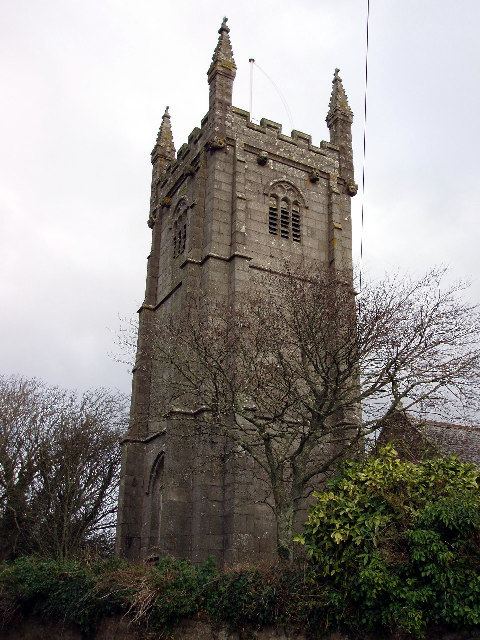Local time Tuesday 4:44 PM | ||
 | ||
Weather 11°C, Wind W at 16 km/h, 92% Humidity | ||
St paul s cathedral bellmen in ludgvan cornwall uk
Ludgvan (/ˈlʌdʒən/ LUJ-ən; Cornish: Lujuan) is a civil parish and village in Cornwall, England, United Kingdom. The village is 2 1⁄2 miles (4.0 km) north-east of Penzance. Ludgvan village is physically split between the area known as Churchtown, situated on the hill, and Lower Quarter to the east, adjoining Crowlas. For the purposes of local government, Ludgvan elects a parish council every four years and the principal local authority is Cornwall Council.
Contents
- St paul s cathedral bellmen in ludgvan cornwall uk
- Map of Ludgvan Penzance UK
- History
- Parish church
- Mining
- Governance
- Tremenheere
- Culture and sport
- Legends
- Notable residents
- References
Map of Ludgvan, Penzance, UK
History
Like many communities in Cornwall the legendary origins of Ludgvan are attributed to the arrival of its patron saint, in this case Saint Ludowanus. However, the place-name appears to derive from the Cornish for place of ashes or burnt place. Evidence for it being a saint's name includes documents in which it is named St Ludgvan and records of its name as Lewdegran and Ludewon. In recent times Ludgvan feast has celebrated St Lewdegran.
Ludgvan was mentioned in the Domesday Book (under the name of Luduhan) as falling within the manor of Ludgvan Lese, which at the time of record covered more of what is now the Penwith district including some parts of the modern parish of St Ives. The Lords of the manor of Ludgvan Lese kept certain shipping rights within the port of St Ives up to and possibly beyond the 19th century. Ludgvan Lease now exists as a hamlet within the parish. At the time of Domesday Book the manor had 3 hides of land and land for 15 or 30 ploughs. It was held by Richard from Robert, Count of Mortain; there were 12 ploughs, 8 serfs, 14 villeins and 40 smallholders. There were 300 acres of pasture, 27 unbroken mares, 22 cattle, 17 pigs and 140 sheep. The value of the manor was £3 sterling though it had formerly been worth £5.
On 12 January 1319, probate records indicate that the Church of St. Ludevon was in the town of Treguwal. Perhaps Treguwal (etymology: Tre = farm, place; Guwal, gweal = arable land) is either the nearby village of Gulval or a medieval name of Ludgvan's lower quarter.
Parish church
The church is dedicated to Saint Ludowanus and later jointly with Saint Paul the Apostle. It is probable that the original idea of a Saint Ludgvan began in the eleventh century. In 1316 it was referred to in probate records as the Church of St. Ludevon. The church was rededicated in 1336. Early spellings of the place-name vary between forms with and without 'Saint' referencing and differentiating the church and its surrounding churchtown. The building was originally cruciform and Norman but was rebuilt in the 15th century with a tower. In 1840 a south aisle replaced the previous transept and porch. The feast traditionally celebrated in the parish is the Sunday nearest to 22 January, in observation of the Conversion of St Paul. The last church services conducted in Cornish were in Ludgvan in the late 17th century (this claim is also made for Towednack).
There are four Cornish crosses in the parish; one is at Crowlas, another at White Cross (this has a cross on one side of the head and a crude crucifixus figure on the other) and two are in the churchyard.
Mining
There was once a number of mines within the parish. Rospeath mine closed (in circa) 1856 and made large returns for the investors. There was no adit and the mine only worked to 4.5 fathoms (8.2 m) depth. The mine was reopened in December 1879 with an adit being cut, machinery erected to pump out the water and to sink a shaft. The width of the lode in the shaft is from 2 1⁄2 feet (0.76 m) to 3 feet (0.91 m). The mine is bounded by Wheal Bolton on the west, Wheal Fortune on the east and to the south Wheal Darlington, Wheal Virgin and others known at the Marazion Mines.
Governance
Ludgvan elects a parish council every four years and the principal local authority is Cornwall Council. The civil parish population at the 2011 census (including Brunnion) was 3,261, whereas the electoral ward population which also covers the above plus the surroundings up to the North Cornish Coast at Zennor was 4,145 at the same census.
Tremenheere
At Tremenheere is the Tremenheere Sculpture Garden. The meaning of Tremenheere is "Standing Stone Farm" (Tre = place/farm, Menhir = standing stone) and there is another place of the same name in St Keverne. The family of Tremenheere derive their name from the estate they held at Tremenheere from medieval times. Their coat of arms is "Sable three Doric columns palewise Azure" with the Cornish motto: "Thrugscryssough ne Deu a nef".
Culture and sport
The village has an Old Cornwall Society.
Ludgvan AFC currently play in the Jolly's Cornwall Combination League at their home ground of Fairfield. Ludgvan Cycling Club generally meets at the Community Centre on Sunday mornings.
The local community radio station is Coast FM (formerly Penwith Radio), which broadcasts on 96.5 and 97.2 FM.
Legends
It has been claimed that Ludgvan was the home of the last native wolf in Great Britain. This cannot be confirmed by available historical sources.
